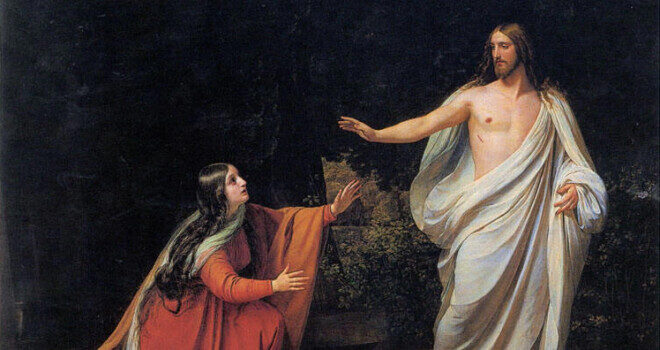Supposing him to be the gardener, she said to him, “Sir, if you have carried him away, tell me where you have laid him, and I will take him away.” (Jn 20:15)
In Mark’s account of Jesus’ resurrection, Mary Magdalene and the other women with her are “amazed,” and “seized with trembling and bewilderment” at the announcement of the heavenly visitor inside Jesus’ otherwise empty tomb (Mk 16:8). In Matthew’s account, Mary and the women were “fearful but overjoyed” (Mt. 28:8); in Luke’s account, they were simply “terrified” (Lk 24:5). In none of the three synoptic Gospels is there mention of Mary Magdalene confusing an angel—let alone Jesus himself—with the cemetery maintenance guy. So it’s interesting that John includes this seemingly unnecessary and insignificant detail about a “gardener,” one which doesn’t seem to correspond with the accounts recorded by the other Gospel writers. What are we to understand by this?
Well, let’s first realize that with regard to the various recorded accounts of Jesus’ resurrection, there was a certain amount of “borrowing” from each other that necessarily came into play, given the fact that no one witnessed for themselves Jesus’ actual rising from the dead. One day he was buried, a stone rolled in front of his tomb, soldiers guarding the entrance so as to avoid any hoaxes or conspiracies theories from forming. And then three days later…Jesus was just gone. Now all four accounts agree that it was Mary Magdalene and the women who were with her who were first made aware of Jesus’ empty tomb and who subsequently announced this astonishing news to the Eleven; for this, Mary has earned the title, “Apostle to the Apostles.” But what explains the fact that John’s version of how Mary came to discover the risen Jesus is so different from the other three accounts?
The most obvious answer is simply that one’s perspective of an event is going to affect how that event is relayed to others. If I were to write down my memories of my wedding day, I might entitle my story, “The Best Day of my Life.” But a guest at my wedding who perhaps knew no one in attendance but the bride and groom might entitle her story, “The Most Boring Day of my Life.” It’s all about perspective.
But there’s something else besides perspective that explains John’s including the detail about the gardener. It was a detail to which he would have been privy, but one of which none of the other three Gospel writers were aware. Let’s understand why that is. Let’s remember, John took Mother Mary “into his home” (Jn 19:27). He not only had his own point of view to reference, but he also had the benefit of hearing Mother Mary’s firsthand account as well. What does this have to do with Mary of Magdala? A lot, actually. According to the Eastern tradition, “Mary Magdalene continued her mission as an evangelist, contemplative, and mystic in the heart of the Church…she went to Ephesus with the Virgin Mary and died there” (“Litany to St. Mary Magdalene,” The Catholic Company). In other words, Mary Magdalene would have lived in the same town as—and quite possibly in community with—the Blessed Mother; therefore, by definition, she would have lived in community with St. John the Evangelist as well. Unlike the other Gospel writers, St. John could have known the detail about the gardener because it may have been Mary Magdalene herself who told him.
Which leaves us with just one question. Why is it that Mary Magdalene mistook Jesus for a gardener to begin with? Certainly, we understand that Jesus, in his glorified state, would have been unrecognizable to the downcast souls who loved and missed him so much. It would take a spark of grace to open the eyes of their hearts to the truth of who they beheld before their eyes. But…why a gardener? Is the explanation really as simple as the fact that a landscaper is the only person that would make sense to Mary to be walking among the tombs that early in the morning? Perhaps. And yet…does Scripture ever really leave us with unnecessary details just for the sake of historical accuracy? Not likely. Each word that comes from God is meant to lead us to ponder. Seen from this light, what do we see when we look at the “gardener” whose face Mary Magdalene gazed upon?
“… the gardener cuts the green shoots from the root of the bush, not to kill the rose, but to make it bloom more beautifully.” —Ven. Fulton Sheen
Jesus, the “Gardener,” had sown His word in Mary Magdalene’s heart, pruned and cut the unhealthy shoots from her life and rooted out what kept her from flourishing…so that she could bloom and grow! It was Jesus—the Good Shepherd, the Lamb of God, the Messiah, but also the Gardener—who saved Mary’s life from destruction. The Good Shepherd will leave the ninety-nine in search of the one soul, carrying him home on his back if he has to. But it is the Gardener who churns up the soil of our hearts, gently holding our chins and turning our heads to face our weaknesses, our faults, our failings and our pain, not to destroy us but to help us grow. The cultivation of the gardener is both painful and agonizing, but the fruit of his handiwork is forever sweet.
The watchmen came upon me, as they made their rounds of the city: Have you seen him whom my heart loves? I had hardly left them when I found him whom my heart loves. (SS 3:3)
Ivanov, A. (1836). The Appearance of Christ to Mary Magdalene [painting]. Retrieved from Wikimedia Commons.










